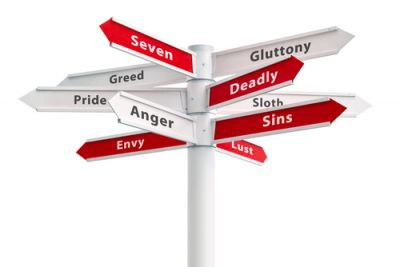 In contrast to the seven virtues are the seven cardinal sins. Under Christian philosophy, the seven deadly sins are vices that lead to other immoralities. Generally, the concept of these sins is thought to come from the Catholic Church, but because this concept has penetrated the culture at large, it’s important to have an understanding of them.
In contrast to the seven virtues are the seven cardinal sins. Under Christian philosophy, the seven deadly sins are vices that lead to other immoralities. Generally, the concept of these sins is thought to come from the Catholic Church, but because this concept has penetrated the culture at large, it’s important to have an understanding of them.
The list of seven deadly sins never really appears in the Bible. Galatians 5 refers to serious sins, such as fits of anger, drunkenness, and sexual immorality. Proverbs 6 refers to “six things the Lord hates,” including murder, false witness, people who stir up conflict and liars.
The list of seven deadly sins probably came from Evagrius the Solitary, a fourth century theologian and monk. He classified eight patterns of evil thought, and did not create the list but simply refined theories from Aristotle and Horace. In AD 590, Pope Gregory I used Evagrius’ list to create the classic list we know today.
Quick Overview of the Seven Deadly Sins
Over the next few weeks, we’ll be taking an in-depth look at these seven sins:
- Lust: Defined as an intense longing, lust is usually associated with sexual desire. However, it can also refer to a lust for power or money. Generally, lust is considered the least serious sin of the seven.
- Gluttony: This word derives from a Latin word that means to “gulp down.” Gluttony is often associated with food, but as with lust, it can refer to many other ideas. It can be a form of selfishness, putting your own interests above those of others.
- Greed: Similar to lust and gluttony, greed is a sin of desire. Greed is defined as an “intense or selfish desire for something,” typically material possessions or wealth. Biblically, it could be considered the love of money or worshipping an idol.
- Sloth: If you’re thinking about the slow-moving mammal when you hear the word sloth, you have a mental picture of the sin. Sloth is apathy, sluggishness, or listlessness. It’s laziness, a failure to do the things that you know you should. The saying “evil exists when good people fail to act” might be attributed to sloth. Sloth is the one sin that isn’t about distorted love for something else.
- Wrath: Although wrath is often thought of as anger and hatred, it goes much deeper than that. It’s a sense of vengeance. Wrath is hate that gets violent and persists for years, if not decades. Anger in itself isn’t a bad feeling. It’s when that anger is directed at an innocent person or when you want to harm someone that the sin occurs.
- Envy: As with greed and lust, envy is a corrupt version of desire. Envy is deep jealousy. You want what someone else has, to the point that you may take it without justification. Envy is often considered the second most deadly sin. It can weigh the soul down more than other sins except pride.
- Pride: This deadly sin is considered the most serious of all the deadly sins. Pride is believing that you are superior to others, whether or not that is rational. Pride puts your own desires and wants before the welfare of others. A prideful person may not admit that he or she has limits or faults. C. S. Lewis called pride “the devil’s most prominent trait.” Proverbs warns people that “pride goeth before a fall.” Pride is thought to lead to all the other sins.
The Seven Deadly Sins in Culture
Dante’s poem “The Divine Comedy” uses the seven deadly sins as structure for the second book, but many authors and artists have depicted the seven deadly sins in their work. Understanding the context of the sins can give you a better understanding of art and literature.
One example is from “Charlie and the Chocolate Factory.” Augustus Gloop represents gluttony and Veruca Salt is a good example of greed and envy. Mike Teavee portrays wrath and sloth, while Violet Beauregard exemplifies pride. Knowing this adds a new dimension of understanding to the book. It’s a delightful story with a deeper meaning.
Delving into the seven sins should be an interesting look at how morals formed over the centuries. It’s not about condemnation, but about understanding how people think about sin and immorality.



